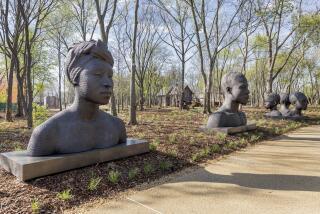What to do along the Blue Ridge Parkway
Picture the Blue Ridge Parkway as a crooked spine running through the Appalachian Mountains. Government stewardship of public lands is splashed across the map in confusing variety a national park at either end, national forests, historic sites, monuments and state parks along its 469 miles.
Most of us know it as the road that snakes through some of the most glorious fall color in North America and wraps around some of the highest mountains east of the Mississippi River. All those curves and dips offer up opportunities aplenty for hiking, fishing, picnicking, camping and viewing waterfalls.
Although it is administered by the National Park Service, the parkway is not really a park. Most of its manmade attractions are technically off the parkway in small communities within an easy drive. The attractions are diverse and many and range from wine-tasting to theater, bluegrass music to a train ride.
Here are my recommendations for attractions to see on or near the parkway. My list starts near the southern end, by Great Smoky Mountains National Park near the North Carolina-Tennessee state line, and runs north and east into Virginia and Shenandoah National Park.
Ride a train: The Great Smoky Mountain Railroad boards passengers in Bryson City, North Carolina, 13 miles from the southern entrance to the Blue Ridge Parkway. Excursions, usually three to four hours, run along the Tennessee and Nantahala rivers and across Fontana Lake, or to historic Dillsboro. It’s a particularly fun way to see fall color, and there’s a railroad museum at the depot with model layouts. 226 Everett St., Bryson City; 800-872-4681; https://www.gmsr.com
Learn about Native American culture: The town of Cherokee https://visitcherokeenc.com, two miles from the southern end of the parkway) is the home of the Eastern Band of Cherokee Nation. Oconaluftee Indian Village is a replica of an Eastern Cherokee community from the 1760s, with demonstrations of Cherokee dance, mask-making, basket-weaving and other traditions. Closes for the season Oct. 18. 218 Drama Rd.; 866-554-4557. The Museum of the Cherokee Indian tells the story of the Cherokee people and has an extensive collection of artifacts. Open daily year-round. 589 Tsali Blvd.; 828-497-3481;www.cherokeemuseum.org. The Eastern Band of Cherokee Nation also operates Harrah’s Cherokee Casino Resort, with the usual games. 777 Casino Dr.; 828-497-7777; https://www.harrahscherokee.com.
Tour a palace:George W. Vanderbilt’s Biltmore House, with 250 rooms, is the largest privately owned mansion in America. Tour the palatial house as well as much of the 8,000-acre estate, which includes wine-tasting, botanical gardens, even a horseback ride in the backwoods of the estate. Christmas season, when the estate is elaborately decorated, also brings special events. 1Lodge St., Asheville; 3 miles from parkway exit at Milepost 388.8; 800-411-3812; https://www.biltmore.com.
Go to the theater.About 30 miles south of Asheville is Flat Rock Playhouse, 60-year-old professional equity theater and official State Theatre of North Carolina. The Playhouse hosts productions from mid-February to December. 2661 Greenville Hwy., Flat Rock; about 25 miles from parkway exit at Milepost 393.6; 828-693-0731; https://www.flatrockplayhouse.org. The Carl Sandburg National Historic Site, former home of the Pulitzer-winning poet, is across the street from the Playhouse; https://www.nps.gov/carl.
Climb the highest mountain:32 miles northeast of Asheville and just north of the parkway is Mount Mitchell State Park, named for the 6,684-foot peak that is the highest point east of the Mississippi. You can drive almost to the top, then walk a short trail to a deck on the summit where on a clear day, the view is said to extend for 85 miles. At the top is an interpretive center and hiking trails, and nearby is a restaurant that is open daily May through October. 2388 North Carolina 128, Burnsville; Milepost 355.4; https://www.ncparks.gov/Visit/parks/momi/main.php.
Visit history:When Moses and Bertha Cone built their country estate in Blowing Rock, they pulled out all the stops. Along with their 13,000-square-foot grand Colonial Revival style mansion, they put in 25 miles of trails, ponds stocked with trout and bass, an apple orchard, white pine forest, carriage house and apple barn. Today the mansion one of the few manmade attractions on the parkway has handmade crafts by members of the Southern Highland Craft Guild for sale, and craft demonstrations by local artists. You can still walk the trails or take a horseback ride through the property. Moses Cone Manor, 667 Service Road, Blowing Rock, Milepost 294; https://www.blueridgeheritage.comorwww.nps.gov/blri.
¿Hang out in Mayberry: Mount Airy, North Carolina, about 20 miles east of the parkway, is where Andy Griffith grew up, and the small town plays the connection for all it’s worth. You can visit Wally’s Service Station, eat at the Blue Bird Diner, see a show at Andy Griffith Playhouse, visit Andy Griffith’s childhood home or take a tour by a Mayberry squad car. Mayberry Days is celebrated the last weekend of September (Sept. 25-27 this year). Exit at Milepost 199.5 at Fancy Gap; https://www.visitmayberry.com.
Go wine-tasting: Mount Airy is the jumping off point for the Yadkin Valley Wine Trail, which has 36 wineries (www.yvwt.com) that grow more than a dozen varieties of grapes in a region once planted with tobacco. Where you go depends in part on how far you want to range from the Blue Ridge Parkway. Coming up: The Yadkin Valley Grape Festival on Oct. 18 in Yadkinville (https://yvgf.com).
Listen to the music: The Blue Ridge Music Center in Galax, Virginia, has live traditional music every day in season from noon to 4 p.m., concerts most Saturdays. The Roots of American Music exhibit traces the region’s musical heritage to the African banjo and the European fiddle. The center is open daily through Oct. 27. Two hiking trails start here. Milepost 213; 276-236-5309;www.blueridgemusiccenter.org. The nearby Rex Theater has bluegrass concerts that are broadcast live on WBRF 98.1 FM listen before your trip to get in the spirit. (113 E. Grayson St., Galax;276-236-0329; https://www.rextheatergalax.com.)
See history come alive: Mabry Mill, a historic water-powered mill, operated first as a sawmill and later as a community gristmill that ground corn into grits. Both have been restored. A trail around the mill connects historical exhibits about life in rural Virgina. There’s also a working blacksmith shop, picnic areas, a hiking trail, and a restaurant. On some days there are demonstrations by historical interpreters. The Rocky Knob Recreation Area, with campsites and hiking trails, is nearby (Milepost 161.1). 266 Mabry Mill Rd. at Milepost 176.2;276-952-2947;www.visitblueridgeparkway.com/mabry mill.php.
Do a little more wine tasting: Five wineries plus Blacksnake Meadery (made with fermented local honey) and Foggy Ridge Cider (sparkling cider, apple port) are west of Roanoke and just north of North Carolina. Most open only on weekends, then close for the season or cut back their hours in November or December. Closest wineries are at Mileposts 171.5 and 174.www.mountainroadwineexperience.com.
Listen to more bluegrass: The Floyd Country Store offers traditional Appalachian music every weekend, year-round. It’s one of the most famed stops on the Crooked Road, Virginia’s Heritage Music Trail, offering music and dancing Friday nights, Americana music Saturday afternoons, an old-time dance or concert on many Saturday evenings, and a traditional mountain music jam every Sunday. The store has a cafe and ice cream counter and sells local crafts, music DVDs, and goods usually found in a country store. 206 S. Locust St., Floyd, Virginia, 6 miles off the parkway at Milepost 165.2; 540-745-4563;www.floydcountrystore.com. For other music venues along the Crooked Road: https://www.myswva.org/swva/see-and-do/music.
Explore Roanoke’s railroad roots: Before the Shenandoah Valley Railroad (forerunner of the Norfolk and Western Railway) came to the Roanoke Valley in the second half of 19th century, Roanoke was a small community called Big Lick for its salt marshes, or licks. Rail-related commerce boosted it to a city. The Virginia Museum of Transportation’s collection includes more than 50 rail cars and the largest collection of diesel locomotives in the South, as well as displays on other transportation. 303 Norfolk Ave. SW, Roanoke, Milepost 115; 540-342-5670; https://www.vmt.org. Nearby is the O. Winston Link Museum, which features the work of the photographer, Winston Link, who documented the last days of steam along the Norfolk and Western Railway. 101 Shenandoah Ave. NE; 540-982-5465; https://www.linkmuseum.org.
Visit a pair of Civil War generals: Two Confederate generals, Thomas Jonathan “Stonewall” Jackson and Robert E. Lee are buried in Lexington, Virginia. Jackson is in the Stonewall Jackson Memorial Cemetery (314 S. Main St., 540-463-3777,https://visitstonewall.com), along with other Confederate veterans. You can also visit the Stonewall Jackson House (8E.Washington St., 540-464-7704, https://www.stonewalljackson.org). The house, now a museum, is owned by the Virginia Military Institute, where Jackson taught before the Civil War. After the war, Lee, general-in-chief of Confederate forces, served as the president of Washington College (now Washington and Lee University). He was buried underneath Lee Chapel at the university (100 N. Jefferson St., 540-458-8768,www.wlu.edu/lee-chapel-and-museum). Lexington is 11 miles off the parkway at Milepost 45.6.
Go caving:About 60 miles east of the end of the parkway and about 15 miles from the Thornton Gap entrance to Shenandoah National Park are Luray Caverns, largest caverns in the eastern United States. The series of limestone chambers have elaborate formations Saracen’s Tent, with thin, fabric-like pleats of stone; the Great Stalacpipe Organ, on which the stalactites sing when they are tapped; and more. The commercial attraction also has a maze and a vintage car exhibit. 101 Cave Hill Rd., Luray; 540-743-6551;https://luraycaverns.com. Other smaller caverns that are closer to the parkway include Dixie Caverns in southwest Virginia (about 25 miles from the parkway at Roanoke, Milepost 115; https://www.dixiecaverns.com) and Linville Caverns in North Carolina (www.linvillecaverns.com, exit at Milepost 317).
TIPS FOR DRIVING THE BLUE RIDGE PARKWAY
The elevation of the Blue Ridge Parkway varies from 650 feet to over 6,000 feet. The first leaves to change color are those at the highest elevation. If you’re there in early fall, head for the highest elevations. If you’re late, the best color will be at lower elevations. Usually peak season is mid to late October; call the Parkway Information Line (828-298-0398, press option 3) for an update.
Get a good map with mile markers before you go and use it to plan your stops. Most general road atlases don’t show mileage along the parkway. You can download a National Park Service map atwww.nps.gov/blri; click on “plan your visit.” Mile markers start at zero at the north end of the parkway; mile marker 469 is near Cherokee, North Carolina. The Virginia-North Carolina state line is at Milepost 216.9.
Lodgings, restaurants and gas stations are scarce on the parkway. You’ll find these amenities in towns near the parkway. Bring snacks, water and maybe a picnic lunch. Keep an eye on your gas gauge.
The going can be slow during peak color season, especially on weekends and near cities. Expect getting from Point A to Point B to take much longer than usual. Parking can be hard to find at popular stops like Moses H. Cone Memorial Park as well as in nearby towns with lunch stops like Blowing Rock. Making last-minute hotel reservations can be difficult. Plan accordingly and go on a weekday if you can.
Be aware that there may be long stretches of the parkway and nearby especially at higher elevations where your cell phone (and its GPS app) won’t get a signal.
INFORMATION
Blue Ridge Parkway:www.nps.gov/blri,www.blueridgeparkway.org
Great Smoky Mountain National Park:www.nps.gov/grsm.
Shenandoah National Park:www.nps.gov/shen
North Carolina tourism:www.visitnc.com
Virginia tourism:www.virginia.org
Roanoke:www.visitroanokeva.com
Asheville:www.exploreasheville.com,www.romanticasheville.com
Blowing Rock:www.blowingrock.com
Hiking:The Blue Ridge Parkway Association lists trails, ranks each hike as easy, moderate or strenuous and offers maps for most of them. Go towww.blueridgeparkway.organd click on “What to do.”
(c)2014 The Miami Herald
Visit The Miami Herald at https://www.miamiherald.com
Distributed by MCT Information Services
PHOTOS (from MCT Photo Service, 312-222-4194):UST-BLUERIDGEPARKWAY
More to Read
Sign up for The Wild
We’ll help you find the best places to hike, bike and run, as well as the perfect silent spots for meditation and yoga.
You may occasionally receive promotional content from the Los Angeles Times.






